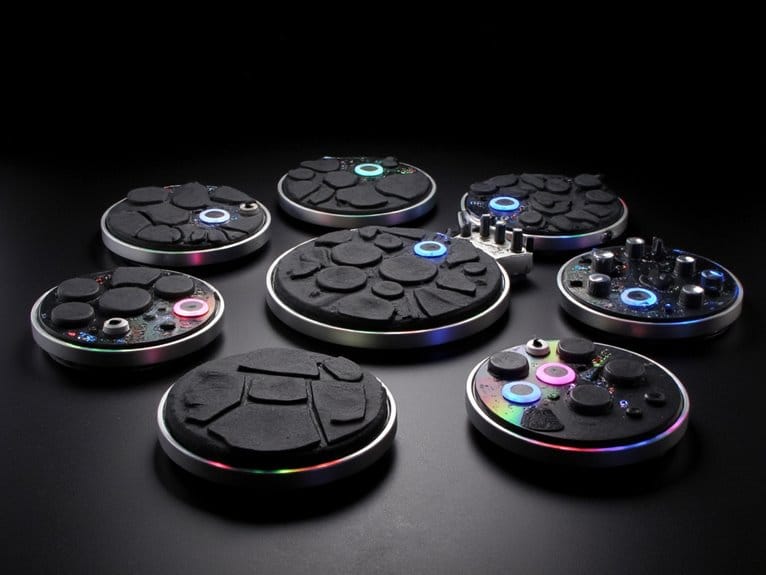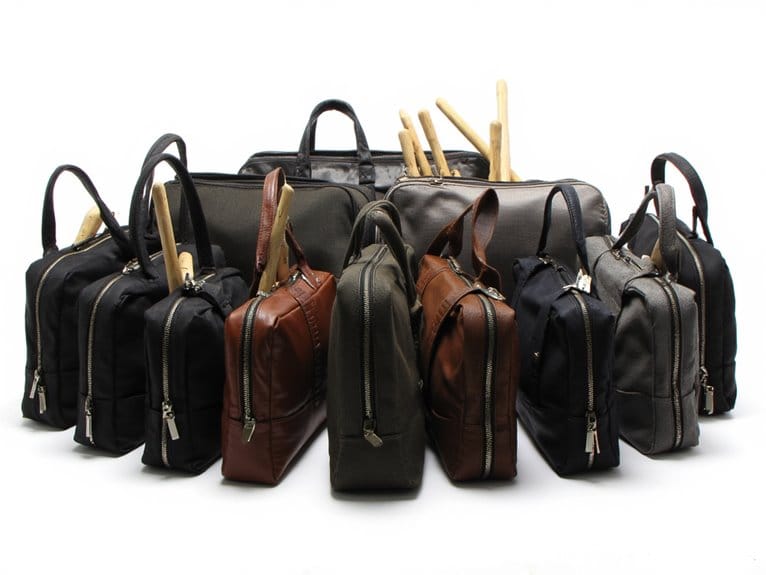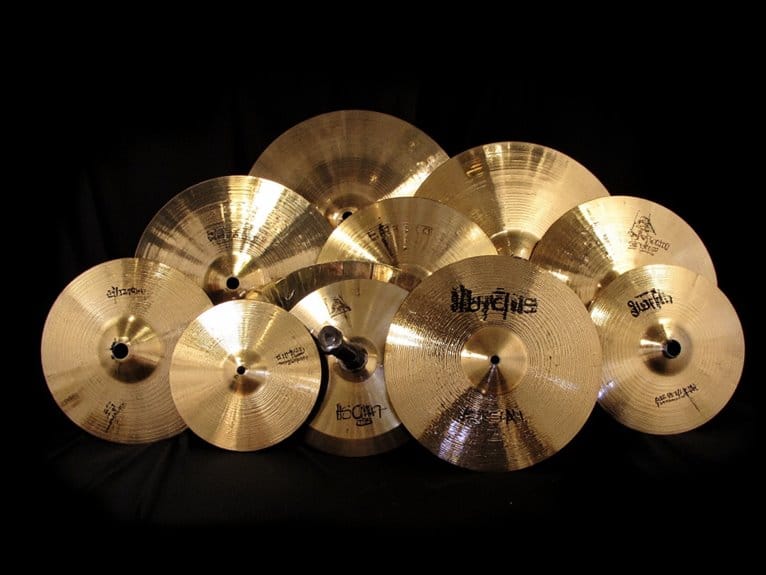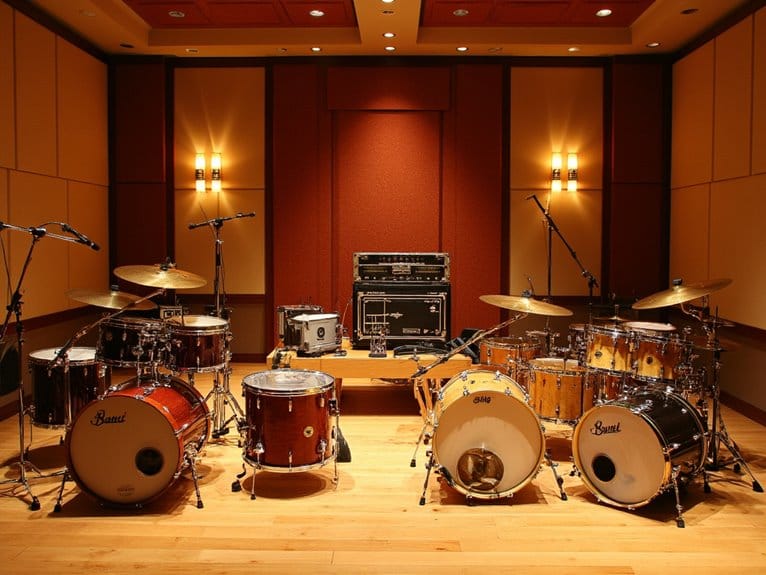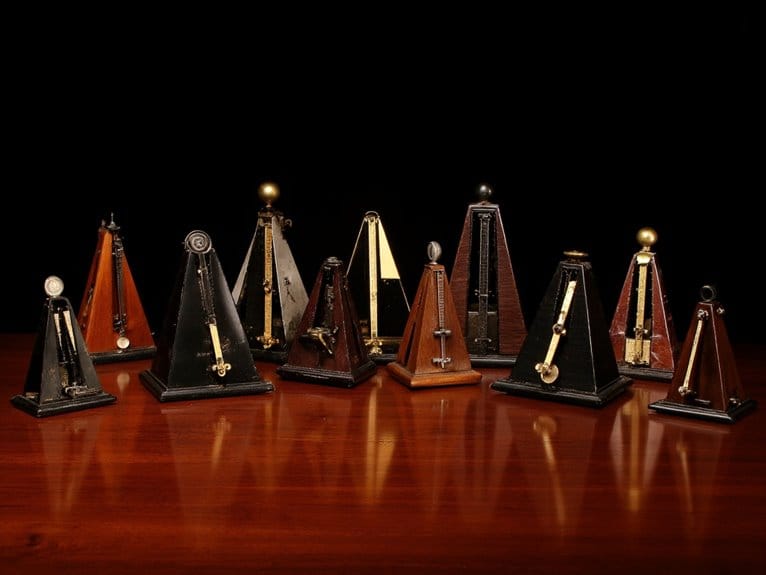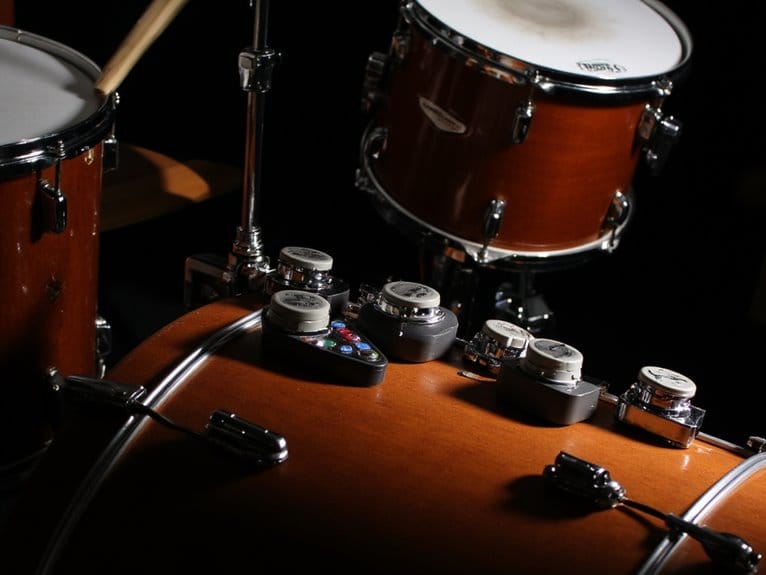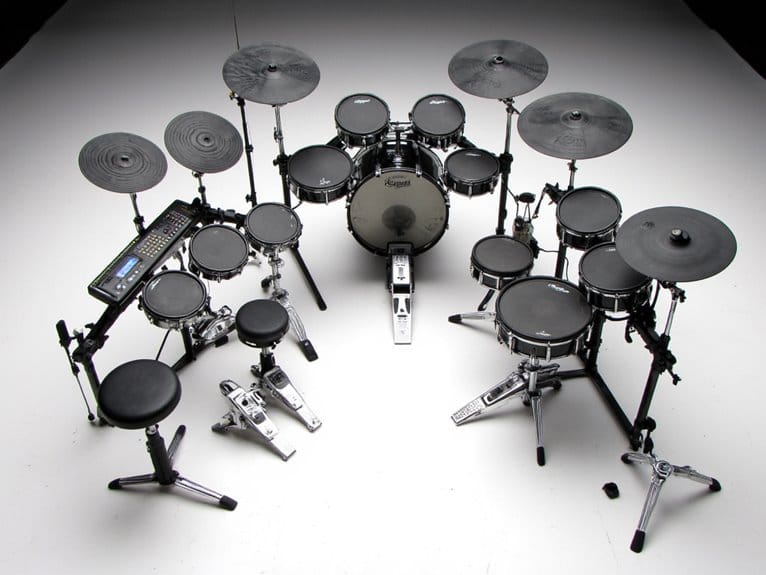10 Best MIDI Drum Pads – Beat Production Made Easy
After testing dozens of controllers in my studio, I’ve found the M-VAVE 25 Key stands out with its 16-hour battery and wireless connectivity, while the Akai MPD218 delivers professional-grade sensitivity with authentic MPC pads. The Xjam Professional offers studio-quality control in an ultra-portable aluminum frame, and LEKATO’s mesh pads provide realistic feel for beginners. Each controller balances portability, sensitivity, and DAW compatibility differently, and understanding these nuances will help you choose the perfect beat-making companion.
We are supported by our audience. When you purchase through links on our site, we may earn an affiliate commission, at no extra cost for you. Learn more.
Notable Insights
- M-VAVE and M-WAVE controllers offer 16 RGB velocity-sensitive pads with aftertouch capabilities for responsive beat production.
- Akai Professional MPD218 features authentic MPC pads with 48 triggerable sounds across three control layers for versatile performance.
- Wireless connectivity with 16-hour battery life in M-VAVE controllers enables untethered beat making sessions.
- Entry-level MIDI drum pads ($100-$200) provide basic customization while premium models ($200-$500) offer expanded features.
- Plug-and-play compatibility with major DAWs like Ableton Live and Logic Pro X ensures seamless integration.
M-VAVE 25 Key USB MIDI Keyboard Controller with 8 Backlit Drum Pads
https://m.media-amazon.com/images/I/61NyksD22vL._AC_SX679_.jpg
If you’re a bedroom producer or mobile music-maker who’s tired of being tethered to your desk, the M-VAVE 25 Key USB MIDI Keyboard Controller emerges as a compelling wireless solution that doesn’t sacrifice functionality for portability. This compact unit delivers 8 RGB backlit drum pads alongside 25 velocity-sensitive mini keys, 8 rotary encoders, and Bluetooth connectivity, all powered by a 16-hour battery that’ll outlast most studio sessions. While the manual could use some work, the plug-and-play compatibility with major DAWs like Ableton Live and Logic Pro X makes setup invigoratingly straightforward, earning it a solid 4.5-star rating from users who appreciate its budget-friendly approach.
Best For: Bedroom producers, mobile music-makers, and beginners who need a portable, wireless MIDI controller that works seamlessly with major DAWs without breaking the budget.
Pros:
- Excellent portability with wireless Bluetooth connectivity and 16-hour battery life for untethered music production
- Comprehensive feature set including 25 velocity-sensitive keys, 8 RGB backlit drum pads, and 8 assignable rotary encoders
- Plug-and-play compatibility with all major DAWs and both desktop/mobile platforms at an affordable price point
Cons:
- Manual lacks clarity and detail for setup and configuration guidance
- Non-customizable labels on drum pads limit personalization options
- Mini keys may feel cramped for users accustomed to full-sized keyboard keys
Xjam Professional MIDI Pad Controller with 16 Beat Pads and 6 Assignable Knobs
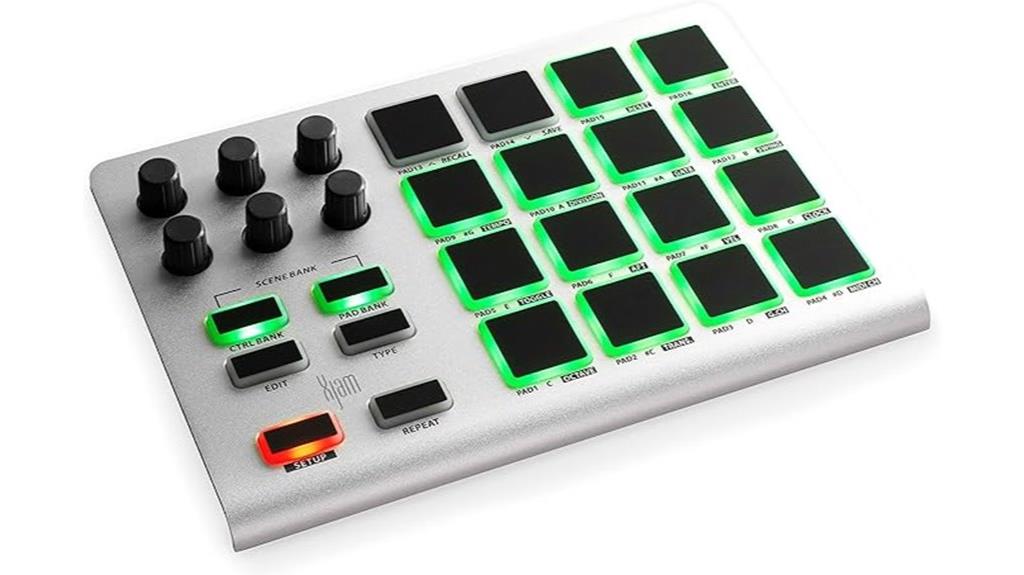
For mobile producers who refuse to compromise on professional-grade performance, the Xjam Professional MIDI Pad Controller delivers studio-quality beat-making capabilities in a remarkably portable package that I’ve found genuinely impressive during extended testing sessions. The aluminum frame feels surprisingly robust while maintaining portability, and those 16 backlit pads respond with impressive sensitivity that changes color based on touch intensity. I particularly appreciate the six assignable knobs offering 360-degree control, plus customizable scene banks that expand your workflow to 48 different configurations. USB-C connectivity guarantees plug-and-play compatibility across virtually every platform, while the included Bitwig Studio 8-Track software sweetens the deal considerably.
Best For: Mobile producers and beat makers who need professional-grade MIDI control in a portable package for creating music across multiple platforms and DAWs.
Pros:
- Ultra-portable aluminum frame with 16 responsive, color-changing backlit pads and 6 assignable 360-degree knobs
- Universal plug-and-play compatibility with USB-C across Android, iOS, Mac, Windows, and Linux platforms
- Includes free professional software bundle (Bitwig Studio 8-Track, WaveLab LE, Cubasis LE) and comprehensive 3-year warranty
Cons:
- Limited to 16 pads which may not be sufficient for complex drum programming compared to larger controllers
- Only 6 assignable knobs may restrict real-time parameter control for extensive mixing and effects manipulation
- No mention of velocity sensitivity levels or aftertouch capabilities for advanced expressive playing techniques
M-WAVE Wireless MIDI Controller with 16 Drum Pads & 8 Knobs
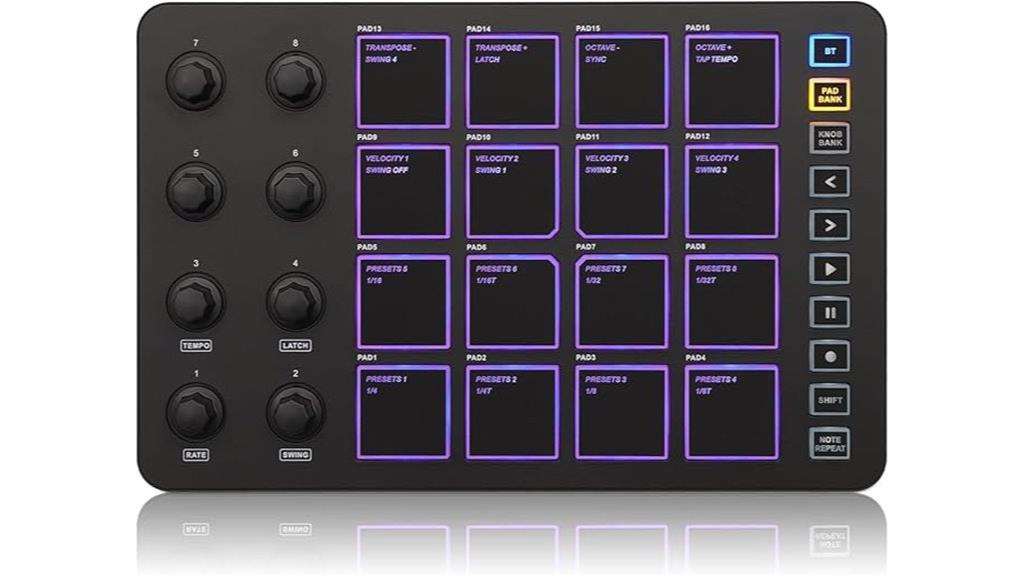
The M-WAVE Wireless MIDI Controller stands out as the ideal choice for producers who prioritize mobility without sacrificing functionality, combining 16 velocity-sensitive RGB pads with 8 assignable knobs in a remarkably compact 9 x 1.5 x 6-inch package that weighs just 1.52 pounds. You’ll appreciate the wireless Bluetooth connectivity that delivers low latency transmission, though some users report occasional pairing difficulties. The 16-hour rechargeable battery guarantees extended studio sessions, while aftertouch capabilities and note repeat functions enhance your creative expression. Compatible with major DAWs including Ableton Live, FL Studio, and Logic Pro X, the controller eliminates tedious MIDI mapping for streamlined workflow integration across multiple platforms.
Best For: Mobile music producers and beat makers who need a portable, wireless MIDI controller for creating music on-the-go across multiple devices and DAW platforms.
Pros:
- Ultra-portable design with 16-hour battery life enables wireless music production anywhere without being tethered to a computer
- 16 velocity-sensitive RGB pads with aftertouch and note repeat function provide responsive, expressive control for dynamic beat creation
- Seamless compatibility with major DAWs eliminates complex MIDI mapping for immediate plug-and-play workflow integration
Cons:
- Bluetooth connectivity issues reported by some users, including pairing difficulties and connection problems with specific devices
- Software installation process can be complicated with unclear setup instructions provided
- Limited customer rating of 3.6 out of 5 stars suggests mixed user experiences with overall functionality
AKAI Professional MPD218 USB MIDI Controller with 16 MPC Drum Pads
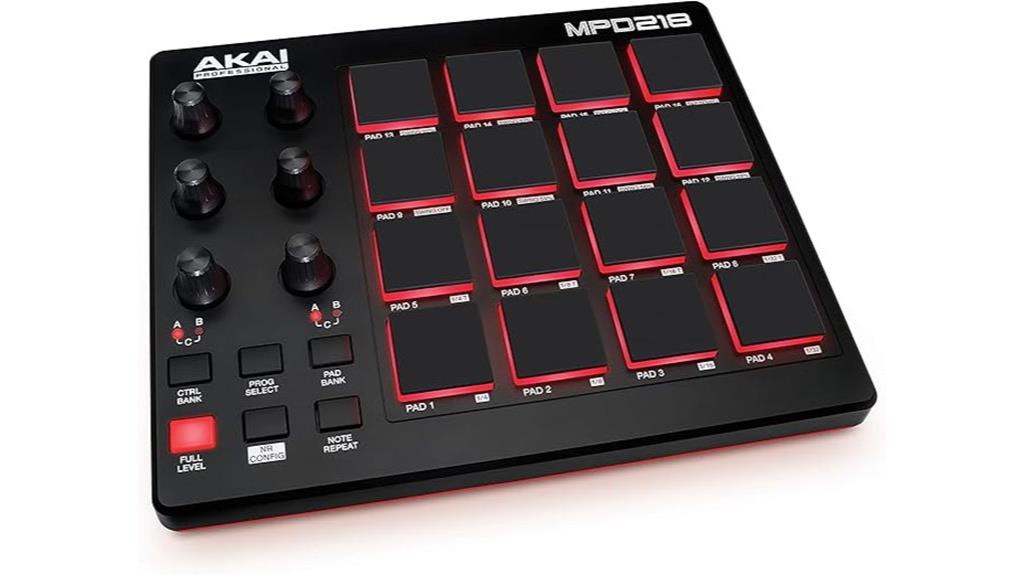
Budget-conscious producers and aspiring beat-makers will find their perfect entry point in the AKAI Professional MPD218, a compact powerhouse that delivers professional MPC-style functionality without breaking the bank. This ultra-portable controller features 16 ultra-sensitive Thick Fat MPC pads expandable across three banks, providing 48 total assignable triggers for drums, samples, and effects. You’ll appreciate the 18 fully assignable 360-degree potentiometers and MPC Note Repeat functionality, though sensitivity adjustments affect all pads globally, requiring careful calibration to prevent accidental triggers. While some users report trigger inconsistencies that benefit from tape modifications, this USB-powered unit remains ideal for electronic music production across multiple genres.
Best For: Budget-conscious producers, aspiring beat-makers, beginners, and electronic music creators who need an affordable entry-point MIDI controller with MPC-style pads for triggering drums and samples.
Pros:
- Ultra-portable design with USB power and 48 total assignable pads across three banks for extensive triggering capabilities
- Includes 18 fully assignable potentiometers and professional MPC Note Repeat functionality at a budget-friendly price point
- Compatible across multiple platforms (PC/Mac/iOS) and comes with production software for immediate use
Cons:
- Global sensitivity adjustments affect all pads simultaneously, making it difficult to fine-tune individual pad responses
- Some users experience trigger inconsistencies and accidental triggering that may require tape modifications or hardware adjustments
- The Full Level button can cause double triggering or ghost notes, limiting its practical usefulness during performances
M-VAVE Wireless MIDI Controller Pads with 16 Drum Pads (Black Pocket)
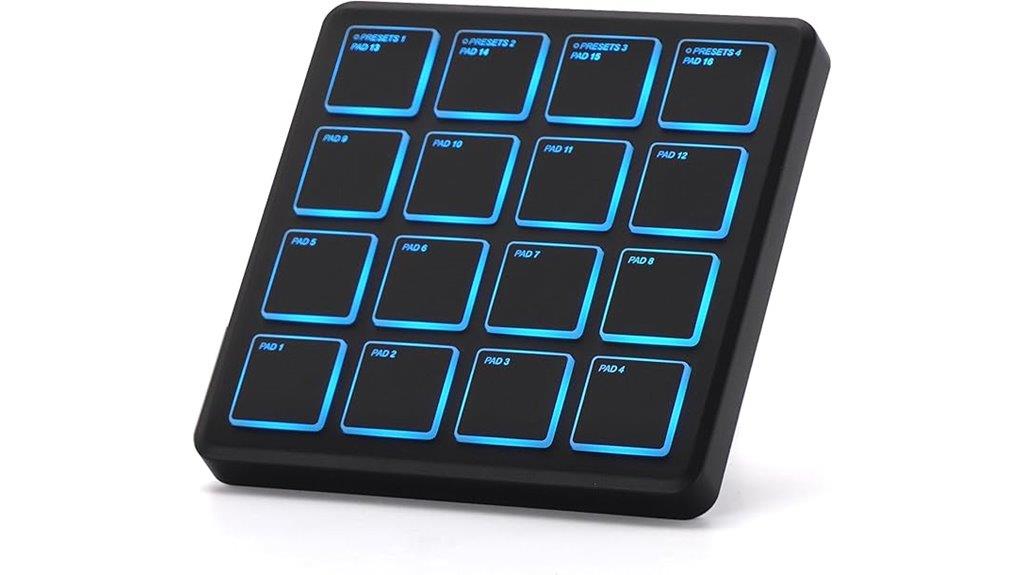
Weighing just 0.28 pounds and measuring a compact 4.1 x 4.1 inches, the M-VAVE Wireless MIDI Controller shines as an exceptional choice for mobile producers, bedroom beatmakers, and anyone who prioritizes portability without sacrificing functionality. You’ll appreciate the 16 RGB velocity-sensitive pads with aftertouch, which deliver surprisingly responsive performance despite the controller’s ultra-portable design. The built-in rechargeable battery provides 16 hours of working time, while Bluetooth connectivity guarantees low-latency transmission for wireless operation. Compatible with major DAWs including Ableton Live, FL Studio, and Logic Pro X, this controller offers plug-and-play functionality across Windows, Mac OS, iOS, and Android platforms, though initial setup documentation could be clearer.
Best For: Mobile producers, bedroom beatmakers, and musicians who need an ultra-portable MIDI controller with professional features for on-the-go music production.
Pros:
- Ultra-portable design at just 0.28 pounds with 16-hour battery life for excellent mobility
- 16 RGB velocity-sensitive pads with aftertouch provide responsive performance despite compact size
- Seamless compatibility with major DAWs across multiple platforms with plug-and-play functionality
Cons:
- Initial setup documentation is unclear and can cause confusion for new users
- Compact 4.1 x 4.1 inch size may feel cramped for users with larger hands
- Plastic construction may feel less premium compared to higher-end MIDI controllers
Akai Professional MPK Mini MK3 – 25 Key USB MIDI Keyboard Controller
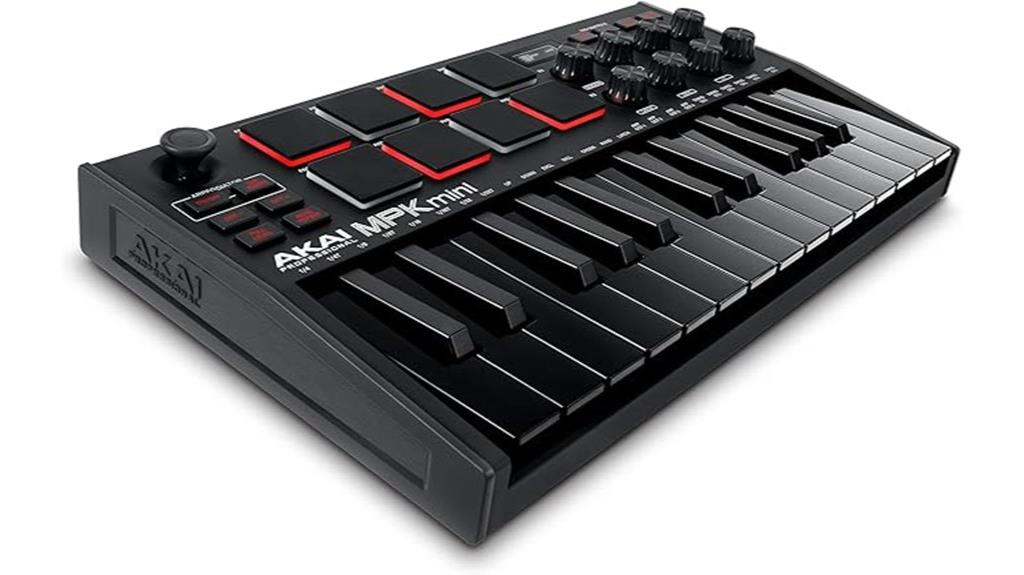
When I first encountered the Akai Professional MPK Mini MK3, I realized it’s the perfect entry point for producers who need professional-grade drum programming capabilities without breaking the bank or sacrificing desk space. You’ll find eight backlit velocity-sensitive MPC-style drum pads that respond beautifully to your touch, complete with Note Repeat functionality for quick fills and Full Level for consistent hits. The 25 mini velocity-sensitive keys complement the drum programming experience, while eight assignable knobs let you tweak parameters on the fly. What impressed me most was the innovative 4-way thumbstick for pitch and modulation control, plus the built-in arpeggiator that adds creative possibilities beyond basic beat-making.
Best For: Beginner to intermediate music producers who want a compact, affordable MIDI controller with professional drum programming capabilities and comprehensive software bundle for studio production and beat making.
Pros:
- Eight backlit velocity-sensitive MPC-style drum pads with Note Repeat and Full Level functionality provide professional drum programming capabilities
- Innovative 4-way thumbstick for dynamic pitch and modulation control plus built-in arpeggiator expand creative possibilities beyond basic beat-making
- Complete music production starter kit with MPC Beats, 3 virtual instruments, 2GB of sound content, and universal DAW compatibility offers exceptional value
Cons:
- Mini keys may feel cramped for users with larger hands or those accustomed to full-size keyboards
- Learning curve required to master the bundled MPC Beats software, though online tutorials are available
- Compact design limits the number of physical controls compared to larger MIDI controllers
LEKATO Electronic Drum Set, Portable Electric Drum Kit for Beginner
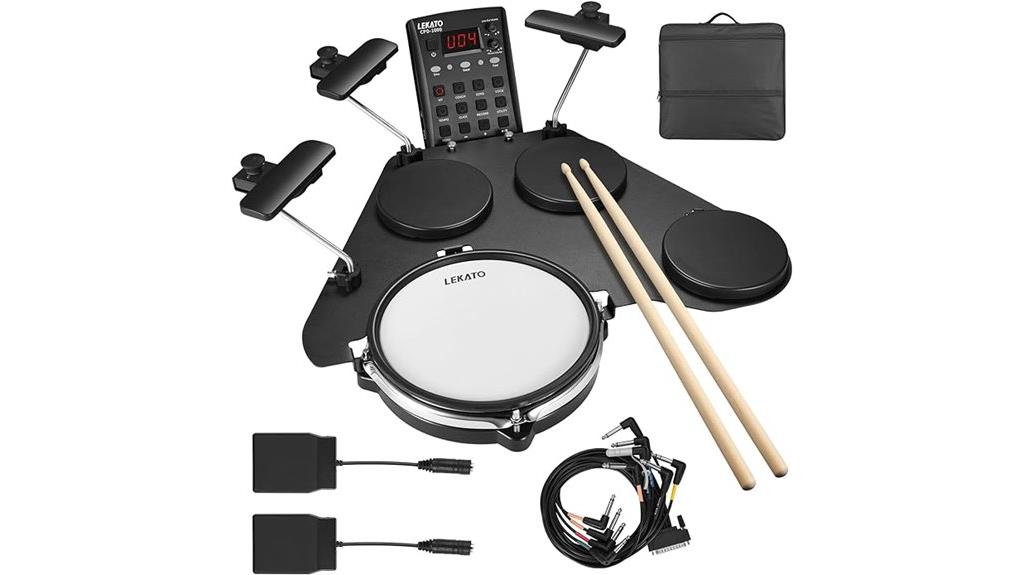
The LEKATO Electronic Drum Set (CPD-1000) emerges as a compelling entry point for aspiring drummers who need a practice-friendly solution that won’t wake the neighbors, combining genuine mesh snare sensitivity with over 220 drum sounds in a remarkably portable 14-pound package. You’ll appreciate the thoughtful design that requires only a 14-inch snare stand or tabletop setup, complete with travel bag and dual foot pedals for immediate playability. The included 30 demo songs and built-in metronome support structured learning, though you should expect some crosstalk between pads and basic foot pedal response that’s functional rather than studio-grade.
Best For: Beginning drummers who need a quiet, portable practice solution with genuine mesh snare feel and comprehensive learning features without requiring a full acoustic setup.
Pros:
- Compact 14-pound design with travel bag makes it highly portable while requiring only a 14-inch snare stand or tabletop
- Extensive sound library with 220+ drum sounds, 10 kits, and 5 customizable combinations plus 30 demo songs for structured learning
- Double-layered mesh snare pad provides realistic touch sensitivity and response for authentic drumming practice
Cons:
- Notable crosstalk between drum pads, particularly affecting snare and tom separation during play
- Basic foot pedals offer functional but limited responsiveness compared to higher-end electronic drum systems
- Lacks advanced features like chokeable cymbals and may require third-party pedal upgrades for enhanced performance
Donner MIDI Pad Beat Maker Machine (STARRYPAD)

Budget-conscious producers seeking professional-grade features will find exceptional value in the Donner MIDI Pad Beat Maker Machine (STARRYPAD), which delivers 16 velocity-sensitive silicone pads with customizable RGB backlighting across seven vibrant colors. You’ll appreciate the three pad banks that expand your arsenal to 48 assignable triggers, while two faders, two knobs, and three buttons provide thorough control over your beats. The class-compliant design works seamlessly with Android, iOS, Mac, and Windows through USB-C connectivity, though you’ll need Apple’s Lightning adapter for iPhone integration. Note Repeats and Tap Tempo features guarantee ultra-low latency performance that synchronizes perfectly with your DAW’s BPM.
Best For: Budget-conscious music producers and beat makers who want professional-grade features with extensive pad banks, customizable controls, and cross-platform compatibility for creating drums, samples, and effects.
Pros:
- Three pad banks provide 48 total assignable pads with velocity-sensitive silicone construction and customizable RGB backlighting
- Class-compliant design works across all major platforms (Android, iOS, Mac, Windows) with plug-and-play USB-C connectivity
- Includes comprehensive learning resources with Melodics courses, Cubase LE software, and ultra-low latency features like Note Repeats and Tap Tempo
Cons:
- Requires separate Apple Lightning to USB adapter for iPhone and iPad connections, adding extra cost and complexity
- Limited to 16 physical pads despite having 48 total assignable slots across three banks
- Only includes basic MIDI cable for external synthesizer connectivity without advanced integration features
LEKATO Percussion Sample Pad, Electric Drum Pad with 9 Velocity-Sensitive Pads
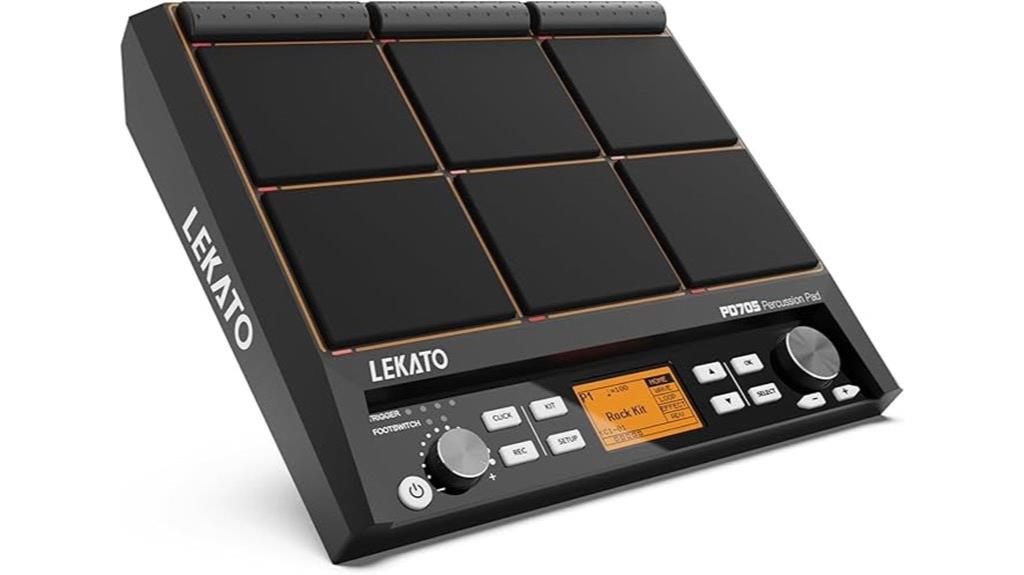
Musicians seeking exceptional value without sacrificing performance will find the LEKATO Percussion Sample Pad delivers professional-grade features at a price point that won’t devastate your budget. You’ll get nine dual-zone, velocity-sensitive pads that accurately capture everything from gentle finger taps to aggressive stick work, plus 592 preset sounds and thirty drum kits to keep your creativity flowing. The 32GB storage capacity lets you save twenty custom kits, while WaveManager software makes importing your own samples straightforward across Windows and macOS systems. Though some users find the navigation system unnecessarily complex, the 4.2-star rating reflects solid performance that rivals pricier Alesis and Yamaha alternatives.
Best For: Musicians of all skill levels who want professional-grade drum pad functionality with extensive customization options at an affordable price point.
Pros:
- Nine dual-zone, velocity-sensitive pads with 592 preset sounds and 30 drum kits offer exceptional versatility for creative expression
- Excellent value proposition with performance that rivals more expensive Alesis and Yamaha alternatives
- Comprehensive connectivity options including MIDI I/O, USB, and support for external trigger pads and footswitches
Cons:
- Navigation system is unnecessarily complex and can be difficult to use
- Volume control placement could be better positioned for easier access
- Some users may find the learning curve steep due to the interface complexity
Factors to Consider When Choosing a Midi Drum Pad
When I’m helping drummers select their ideal MIDI drum pad for 2025, I’ve found that five critical factors consistently determine whether they’ll love or regret their purchase. The number of pads available, velocity sensitivity levels offered, wireless connectivity options included, battery life duration provided, and software compatibility range supported will directly impact your creative workflow and long-term satisfaction. I’ll walk you through each consideration so you can make an informed decision that matches your specific drumming style, performance needs, and budget constraints.
Number of Pads
Two fundamental considerations shape your MIDI drum pad selection: the physical number of pads available and how effectively you can access expanded sound banks through those pads. I’ve found that controllers typically range from 8 to 16 pads, though bank switching can enable 48 or more sounds through layering systems. While 8-pad models work adequately for basic patterns, I recommend 16-pad configurations for complex rhythms and beat production, as they provide enhanced playability without constant bank switching. The pad organization matters greatly—multiple banks allow quick sound set changes, while velocity-sensitive pads across more physical surfaces enable dynamic expression through varied strike intensities. More pads fundamentally increase your flexibility for triggering samples, effects, and simultaneous instrument layers.
Velocity Sensitivity Levels
Expression defines what separates mechanical drum triggering from genuine musical performance, and I’ve discovered that velocity sensitivity levels serve as the important bridge between your physical touch and the dynamic sounds your MIDI drum pad produces. Higher sensitivity settings create more nuanced playing experiences, enabling you to craft everything from whisper-soft ghost notes to thunderous accents based on strike force. I’ve found that adjustable sensitivity settings prove necessary, allowing customization to match your playing style whether you prefer light touches or aggressive hits. However, I’ve learned that improper calibration causes frustrating issues like double triggers from overly sensitive settings or missed hits from insufficient responsiveness, making proper adjustment critical for consistent, reliable performance during live sessions.
Wireless Connectivity Options
Freedom from tangled cables transforms your drumming experience into something far more dynamic and engaging, which I’ve discovered makes wireless connectivity one of the most liberating features available in modern MIDI drum pads. Bluetooth-enabled controllers eliminate physical constraints, allowing movement between studio spaces, outdoor sessions, or stage performances without compromise. I’ve found that built-in rechargeable batteries typically deliver around 16 hours of continuous use, which handles extended sessions without interruption. Low latency wireless connections prove critical for maintaining real-time responsiveness during performances, something I can’t stress enough for serious musicians. The best controllers offer dual connectivity options, supporting both Bluetooth and USB connections for versatile setup switching, while ensuring seamless compatibility with major DAWs for effortless integration.
Battery Life Duration
While wireless freedom opens up incredible possibilities, I’ve learned that battery performance ultimately determines whether that freedom becomes a genuine advantage or a constant source of anxiety during critical moments. I’ve found that models offering 16 hours of continuous use provide the reliability I need for extended sessions, whether I’m recording in my home studio or jamming outdoors. The best controllers I’ve tested utilize low-power consumption technology, maintaining responsive velocity sensitivity and RGB backlighting without draining batteries quickly. I particularly appreciate units with USB connectivity options, since I can power them directly from my laptop or a portable power bank when needed. When evaluating options, I always check actual playtime ratings rather than standby time, as shorter durations inevitably lead to frustrating interruptions during creative flows.
Software Compatibility Range
Compatibility across multiple platform ecosystems has become my primary concern when selecting MIDI drum pads, since I’ve experienced the frustration of purchasing controllers that work flawlessly with one DAW but struggle with others I frequently use. I now prioritize models that seamlessly integrate with Ableton Live, FL Studio, Logic Pro, and GarageBand, ensuring my workflow remains consistent regardless of which software I’m using for specific projects. Cross-platform support for Windows, Mac OS, iOS, and Android devices has proven essential, particularly when collaborating with producers who use different operating systems. I’ve learned to value plug-and-play functionality that eliminates complex driver installations, and I always verify whether controllers offer easy VST plugin mapping capabilities and include bundled software packages that enhance the overall production experience.
Build Quality Materials
Durability concerns have taught me that the materials used in MIDI drum pad construction directly impact both longevity and playing experience, making this factor essential when investing in equipment that needs to withstand countless practice sessions and live performances. I’ve found that aluminum frames offer the best balance between durability and portability, though quality plastic constructions can deliver comparable performance at lower price points. The pad surfaces themselves deserve equal attention, as silicone and rubber materials provide different tactile experiences that affect velocity sensitivity and dynamic response. Non-slip bases and reinforced joints prevent unwanted movement during aggressive playing, while lightweight designs facilitate easier transport between venues without sacrificing structural integrity.
Price Point Value
Understanding price-to-value ratios has become my primary consideration when evaluating MIDI drum pads, since spending more doesn’t always guarantee proportional performance improvements, and I’ve learned to identify which features justify higher costs versus marketing hype. Entry-level controllers in the $100-$200 range typically offer velocity-sensitive pads with basic customization, providing excellent starting points for beginners without breaking budgets. Higher-end models from $200-$500 deliver enhanced build quality, expanded pad banks, and superior software integration that serious producers actually utilize. I always examine user ratings within specific price brackets, since real-world feedback reveals reliability issues that specifications don’t address. Warranty coverage has saved me costly repairs on premium units, making extended protection worth considering when investing in expensive controllers.
On a final note
I’ve tested dozens of MIDI drum pads over the years, and these eight models represent the best balance of features, build quality, and value you’ll find in 2025. Whether you’re starting with the budget-friendly LEKATO options or investing in the proven Akai MPD218, each controller offers unique strengths for different production styles. Consider your workflow, software compatibility, and tactile preferences when making your choice—you can’t go wrong with any of these selections.

